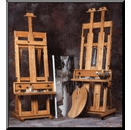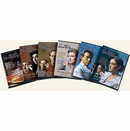MacKinnon Pens

Loading zoom
As featured in PenWorld.
Everyone owns a pen,
but not everyone can own a MacKinnon pen.
"The only true beauty exists in nature and the artist only achieves the sublime when emulating nature."
It is with this ethos firmly in mind that David MacKinnon created the Honeycomb range of luxurious pens. Based on the natural miracle that is the honeycomb, these English, handcrafted pens represent an epoch in pen craftsmanship. Each pen is created using a combination of traditional and innovative techniques.
David MacKinnon
David MacKinnon is a British precision engineer and skilled craftsman with over thirty years experience. His background is in fields as diverse as research and development in telecommunications, aerospace, medical research and Formula One motor sport racing.
In recent years, he has worked with a world-renowned goldsmith producing object d'art and manufacturing enamelled pens for a number of well-known American pen makers. These have received great acclaim on the international stage.
The MacKinnon Pen Company
During the 19th century, Duncan MacKinnon established a pen company known as The MacKinnon Pen Company in Brooklyn, New York. MacKinnon had the original patent for the Stylographic pen and it is known that Mark Twain received one as a gift, a MacKinnon Stylo. He was very impressed with its performance and enthusiastically urged friends to adopt "the best fountain pen yet invented". It is thought that he used this pen during the writing of Huckleberry Finn.

"Having this historical connection with the Clan MacKinnon, it gives me great pleasure to introduce myself to connoisseurs of collectable pens".
MacKinnon Pens
David MacKinnon is a British precision engineer and skilled craftsman with over thirty years experience. His background is in fields as diverse as research and development in telecommunications, aerospace, medical research and Formula One motor sport racing.
In recent years, he has worked with a world-renowned goldsmith producing object d'art and manufacturing enamelled pens for a number of well-known American pen makers. These have received great acclaim on the international stage.
The Product
The MacKinnon pen brings together the three worlds of Nature, Technology, and Craftsmanship. Based on the natural organic wonder of the six-sided wax cells produced by worker bees, the design was achieved by using old world craftsmanship with the added advantage of modern engineering and computer aided design. All component parts, with the exception of the nib and converter section, are traditionally manufactured by the MacKinnon Company's own facilities in England.

The MacKinnon Honeycomb Pen is the first in a series of limited edition writing instruments. A total of fifty fountain pens and twenty-five roller ball pens in each of four translucent colours will be created.
The 'Honeycomb' Collection
The pieces are each handcrafted from .925k sterling silver, hallmarked in London. Each precious component part passes through multiple stages of precision engraving leaving intricate patterns known as guilloché, a technique often used in the creation of Fabergé. This brings illumination to the precious metals. The honeycomb pattern in the cap and the barrel are recessed prior to the guilloché pattern being engraved, leaving the honeycomb form in high relief. The pens are then hard enamelled before being finished with 18k gold.

Hard Enamelling
Enamelling is an extremely skilled craft requiring many years of dedicated practice. The process begins with hand grinding using pestle and mortar. Glass granules are combined with water and ground for many hours until the correct consistency is achieved. The enamel is then cleaned until all impurities are removed. It is applied to all the guilloché areas and then fired in an enamelling oven at very high temperatures causing the enamel to adhere to the precious materials, and leaving a layer of glass inside the honeycombed pattern. This process is repeated many times. Any excess enamel is then removed until the desired levels are achieved. When the final stage of firing is complete, the parts are pumiced and finished.

Nibs
Engineered in Heidelberg, Germany, the 18-karat gold nib is unsurpassed in quality. Coupled with an ebonite feeder, each nib is plated with rhodium and tipped with iridium to ensure durability in fine and medium sizes with “MP” embossed in the nib, all made exclusively for MacKinnon Pens.
Presentation Packaging
Premier packing adds the finishing touch to a Mackinnon pen. The cases are designed and handcrafted by one of England’s finest leather box makers, Wheeler an Oliver. The craftsmanship that they use has been passed down the ages enhancing Mackinnon Pens, a truly traditionally crafted masterpiece.
"At last, a pen maker of distinction who actually makes the pens himself."
HISTORY
The MacKinnon Pen Company
Duncan MacKinnon, a druggist from Stratford Canada, is credited with being the inventor of the first Stylographic fountain pen. He took out a patent but he lacked the funds to begin production. He showed a sample to A.T.Cross who saw that a spring could improve the design and Cross got a patent for the new design. MacKinnon was so annoyed that he asked John Holland of Cincinnati to manufacture the pens for him. To add to the insult, when MacKinnon added a spring to his own pens in 1882, Cross sued him.
Clan MacKinnon
The Clan MacKinnon is a branch of the great Alpin family. It descends from Alpin's third son, Prince Gregor, younger brother of Kenneth MacAlpin, first king of united Scotland.

It was Alpin's great-grandson Findanus, the 4th MacKinnon chief, who gave the clan its name. He owned a castle on the Isle of Mull and Findanus Castle (Dunakin) on the Isle of Skye. This castle was the residence of the Lairds of MacKinnon until the 14th century, when Strathardill, also on Skye, became their seat. Findanus and his bride, the Norse princess nicknamed 'Saucy Mary,' ran a heavy chain from Skye to Lochalsh and levied a toll on all shipping passing up and down.
The MacKinnon associations have always been Hebridean and historically on Skye, Iona, Arran, and Mull. It is on the Isle of Skye however that the majority of the clan estates came to be.
The MacKinnons have been throughout the majority of their history, a small clan with a strong sense of honour. This was evidenced by their conviction to the Jacobite cause in 1715 and 1745 after which they lost their lands. Their assistance to the Bruce was rewarded with the grant of their Skye estate and their ecclesiastical associations are still very evident on Iona.
The MacKinnons supported in force Bonnie Prince Charlie during the 1745 rising and accompanied him throughout his campaigns. The bulk of the MacKinnon army was not at the Battle of Culloden and instead stationed near Inverness. They were among the last to remain at arms.
After 1745, the fortunes of the MacKinnons declined markedly until the mid 19th century when all things Scottish came into vogue. Subsequently, they became successful in politics (with the MacKinnon chief becoming a Member of Parliament), the military and business. However, this latter success is due to individual efforts since the historical family lands have all been lost.
* * *
PRESS RELEASE
Mackinnon Pens Launch Their First Range of Luxury Pens.
West Sussex, England. April 12th 2006
MacKinnon Pens announces the release of their new range of limited edition, luxury pens. The Honeycomb range of pens is handcrafted in England. Prices start from GBP £1945 (USD $3400).
For immediate release
“The only true beauty exists in nature and the artist only achieves the sublime when emulating nature.”
It is with this ethos firmly in mind that David MacKinnon created the Honeycomb range of luxurious pens. Based on the natural miracle that is honeycomb, these English, handcrafted pens represent an epoch in pen craftsmanship. Each pen is created using a combination of traditional and innovative techniques. The pieces are each handcrafted from .925k sterling silver, hallmarked in London. Each precious component part passes through multiple stages of precision engraving leaving intricate patterns known as guilloche, a technique often used in the creation of Fabergé. This brings illumination to the precious metals. The honeycomb pattern in the cap and the barrel are recessed prior to the guilloche pattern being engraved, leaving the honeycomb form in high relief. The pens are then hard enamelled before being finished with 18k gold.
This incredibly limited series runs to only seventy-five creations including fifty fountain pens and twenty-five roller balls.
The new range will be on show at Pen Pavilion at the National Stationery Show in New York in May 2006.
David MacKinnon has been making pens for various other pen companies for many years and has now broken away to produce pens for himself. This has allowed him to pursue his own aesthetic ideals and to create for the more discerning pen client. This freedom has allowed him to create a series of such quality, and to also deal with the requests of his customers directly.
The historic MacKinnon pen company was established in the 19th Century in Brooklyn, New York and held the first patent for the Stylographic pen. Mark Twain was presented with one of their first pens and he was so enamoured by its performance that he remarked that “it was indeed the best fountain pen yet invented.”
About David MacKinnon
David MacKinnon is a British precision engineer and skilled craftsman with over thirty years experience. His background is in fields as diverse as research and development in telecommunications, aerospace, medical research and Formula One motor sport racing.
In recent years, he has worked with a world-renowned goldsmith producing object d'art and manufacturing enameled pens for a number of well-known American pen makers. These have received great acclaim on the international stage.
“Having the historical connection with the clan MacKinnon, it gives me great pleasure to introduce myself to the connoisseurs of collectible pens.”
Copyright © 2002-2025 Madison Art Shop™ LLC. All Rights Reserved.






















